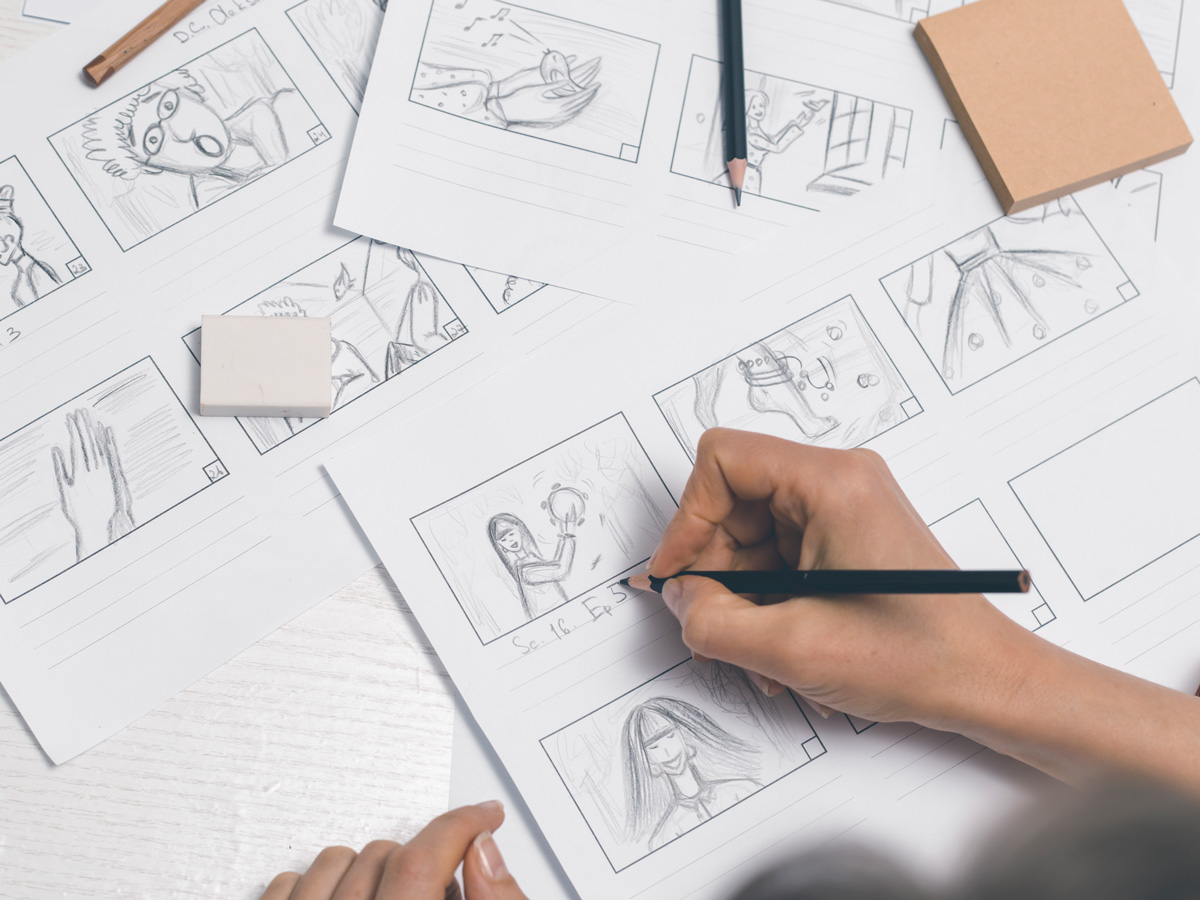Blog > Storyboarding for e-learning
Storyboarding for e-learnings

Written by Rosaria
Every instructional designer uses storyboards for their e-learning project. But… what is a storyboard? Read this post to find out more.

What is a storyboard?
The term “storyboard” comes from the world of cinema and television. It refers to a document, the storyboard, used in the “pre-production” phase (in paper or electronic format) to include all the technical (special effects, framing, camera movements) and artistic elements that make up the final product. The producers therefore sketch out the film with a series of “images” and accompanying descriptions.
A storyboard is to e-Learning design what a blueprint is to architecture.
For an e-learning course, the storyboard is therefore the “plan” of the course, a document that contains not only the content but also all the other elements: graphics, videos, narration scripts, quiz questions, etc. It allows the designer to visualise the different scenes, texts, animations, images/illustrations/drawings, questions, etc. and allows experts and/or sponsors to comment on all these elements before moving on to development.
The purpose of a storyboard is twofold: on the one hand, it allows the designer to organise the content and, on the other hand, it allows him to communicate the “plan” of the course to the experts and the stakeholders. It also allows to review the different parts before development begins. The storyboard helps us to have a coherent approach throughout the course, it is the blueprint for sequencing the content, applying a consistent style, designing meaningful learning activities, giving feedback or instructions to the learner, etc. When working as a team, once the storyboard has been approved, it can be easily distributed to different members: graphic designers, media producers, etc., so that they can do their part simultaneously, thus shortening the overall development time.
Before creating a storyboard
Before starting the production of a storyboard it is necessary to answer several questions, which will help defining the following elements:
Needs analysis
Who is the target audience? What are their skills? What pedagogical strategies should be applied?
Organisation of resources
What learning resources are available? What files are available? How will the course be organised (modules, chapters, etc.)?
Definition of objectives
What is the main objective? Are there secondary objectives?
Selection of the learning technique
How should the content be presented? With storytelling? A scenario-based approach? Another method?
Order of content
What is the order of the content? Which topics should be presented before the others?
The elements of a storyboard
Although each project is different and has a format that better suits learning needs, there are elements common to any storyboard.
NONE
None
Title
Project name, course title, date and any other information that identifies the project.
Reference
This is the name/number of the page/screen to which the rest of the information refers. Each screen/page must be clearly identified to enable you to locate the contents and slides of your module.
On-screen text
The (full) text that appears on the screen and that learners will read, including instructions (“click here”, “see more”, etc.).
Audio
The narration associated with each slide/screen.
Navigation instruction/Interactions
Everything the learner can or should do on the screen, including quizzes and possible answers. It is important to ensure that learners know how to move from one page to another.
Graphic/media elements
All images, animations, videos, including their positioning on the screen. These elements can be described or displayed here as thumbnails.
CLOSE ALL
If you want to know more about the types of storyboard you can create or if you want some best advices, go have a look at these blog posts: Types of Storyboards for e-learnings and What to avoid and what to do when creating an e-learning storyboard.
I also made a demo course (in French) on how to create storyboards for e-learning. Have a look at it on this project page.
Sources, references and links
Other than speaking for my personal experience, all the references and resources that I used to write this article are available here:
- A Simple Guide to Creating An eLearning Storyboard in the blog SH!FT Learning
- 6 Mistakes to Avoid When Writing an eLearning Storyboard in the blog SkillBuilder LMS
- 10 tips to improve your elearning storyboards in the blog Elucidat
- The Power of White Space to Improve Screen Design in eLearning in the blog SH!FT Learning
- The E-learning Framework and Models, by Badrul H. Khan
- Depover, C. & Marchand, L. (2002). Chapter 5 Le design et la production des supports de formation. In: , C. Depover & L. Marchand (Dir), e-learning et formation des adultes en contexte professionnel (pp. 95-124) Louvain-la-Neuve, Belgique: De Boeck Supérieur.
- Dessislava, V. (2010), Storyboard Design for Adaptive E-learning Based on Learning Styles, Proceedings of International Conference on SOFTWARE, SERVICES & SEMANTIC TECHNOLOGIES, September 11-12, 2010, Varna, Bulgaria, ISBN 978-954-9526-71-4, p. 22 http://hdl.handle.net/10506/638
- Khan, B.H. (2004). Comprehensive approach to program evaluation in open and distributed learning (CAPEODL) model. Introduced in the Program Evaluation course. George Washington University.
- Khan B. H. (2007). Program Evaluation in E-Learning, consulted on: http://www.badrulkhan.com.
- Mohd Yusoff N., Salim S.S. (2014) A Review of Storyboard Tools, Concepts and Frameworks. In: Zaphiris P., Ioannou A. (eds) Learning and Collaboration Technologies.
- Designing and Developing Novel Learning Experiences. LCT 2014. Lecture Notes in Computer Science, vol 8523. Springer, Cham DOI: https://doi.org/10.1007/978-3-319-07482-5_8
Related Articles
Related
Assess learners’ learning
There are several storyboard formats and their use depends on what you want to achieve. We will look at three types of storyboard for three different contexts and how to use them.
Create a fill-the-gaps quiz with Storyline
Articulate Storyline360 is a great authoring tool (I use it myself for my learning projects) and it has a lot of fantastic built-in features and quiz types. In particular you can easily create graded questions such as true/false, multiple choice, matching...
What to do and what to avoid when creating an e-learning storyboard
As we’ve seen in the previous article here, there are several types of storyboard and the format used depends on the context. Whatever the choice, here is a list of mistakes to avoid and tips to remember when developing effective storyboards. What to avoid Include too...
